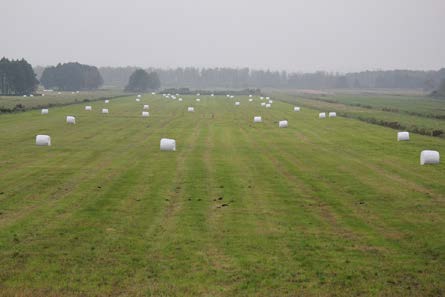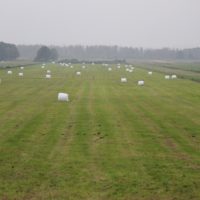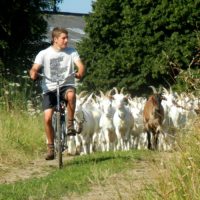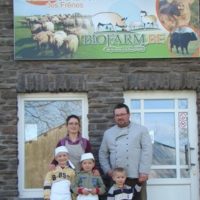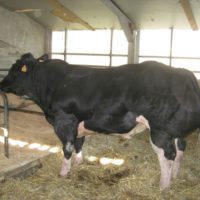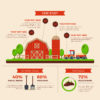Description
Background
The monitored farm is localized in a specific geographical region of the Noteć river valley in the northern part of Wielkopolskie voivodeship. Farms in this region are characteristic by the fact that they are managing in a special habitat of the natural and semi-natural permanent grasslands localized on organic and alluvial soils. The local grasslands in the whole valley on area of 80000 ha are included in the Natura 2000 network and are a special area of conservation and protection of habitat and birds. Agricultural production in this region is orientated on high efficient milk production with the use of local grasslands as the main feed base. The specific habitat with good quality organic and alluvial soils and grassland drainage system can be included as one of the best grassland production regions in Wielkopolskie voivodeship. The presented case study is a multi-generational family farm owned by Mr. Wojciech Piosik and his wife Bogumiła where they are working with their three sons. The farm area is 140 hectares, with the amount of 155.25 total LU of dairy and beef cattle. Forage production for cattle is divided into two parts. It includes 36 hectares of maize for silage using the whole plants and 32 hectares of maize for production of corn grain silage. The 15 hectares of the arable land is used for the cultivation of cereals as a component for concentrate feeds. The second part is grassland feed production, based mainly on the 25 hectares of high efficient permanent meadows, 17 hectares of cut temporary grassland sown on the arable land and 15 hectares of recently purchased, periodically flooded meadows, that are located directly next to the Noteć river. For the project case study and the created excel file these meadows are included as the “rangeland area”. The main animal production is based on the 110 milk cows of the Holstein Friesian breed with the young heifers and calves. Additionally, in the farm 15 beef cattle of different crosses are kept.
Detailed description
The farm was restructured in the 2000 year when the owners focused only on high efficient milk production. Since then the owners increased year by year the dairy production and in 2016 year, they have made a large modernization using the EU funds and bought a fully new machinery for the hay and wilted grass silage production that had improved in a significant way the production. In the further increase of animal production the limiting factor was the amounts of forages. One of the reasonable solutions was to purchase or rent more agriculturally utilized area for forage production. Because of the situation on the local land market, that does not allow to obtain a good quality agricultural land due its high prices, forced the farmer to search for a different solution. In some moment there occurred a possibility to purchase for a relatively low price 15 ha of semi-natural meadows. The main problem of this area was its specific habitat and abandonment of forage production for a long time, which caused significant changes in their botanical composition. With a high share of weeds and low productivity grass species in the botanical composition the meadow sward was not suitable for an efficient milk production. During the growing season the meadows are also periodically flooded by the river waters, what also contributes to the degradation of the botanical composition and time to time disables the possibility of their harvest. The main problem in that moment was, how to optimize the fodder production on such meadows in the specific conditions of organic and alluvial soils and periodic floods. In order to solve the problem, the farmer decided to renovate the newly obtained meadows. First, he regulated the water conditions by cleaning and restoring the existing drainage system and dig some new drainage ditches. The second step was to increase the participation of valuable forage species in the sward. The problem that has appeared, was the lack of seed mixtures containing species resistant to such extreme habitat conditions on the market. All of the seed mixtures offered were composed out of a high-value species however, no mixture included a composition that had in its content grasses resistant to periodically floods. The solution to that problem is the main innovation developed by the farmer presented in the Inno4Grass Project. Due to the lack of seed mixtures containing meadow foxtail, the farmer ordered seeds of this species in a seed company for supplementing the composition of the standard commercial mixture used in renovation. The meadow foxtail is typical grass species which occurs in the botanical composition of flooded meadows in very low share and is naturally present on the Noteć river meadows. It is a grass with good fodder value, resistant to harsh climatic conditions and periodically floods, well-growing on alluvial soils.
Results
The direct result of this innovation worked out in this particular farm, because it is possible to obtain higher and better quality dry matter yields from the new grasslands that were originally very low productive. The extra fodder production can be used as a reserve or for the increase of the herd and animal production. Renovation with the use of the seed mixture with addition of meadow foxtail not only improved the grassland production but also had given the sward better tolerance for floods and the persistence of the performed renovation.
Adoption criteria
Innovation created at the presented farm can be adapted directly by other farmers from the Noteć valley and others that are managing grasslands located directly to rivers that have a tendency to periodic floods. The addition of meadow foxtail to different market grass or grass-legume seed mixtures for the renovation of grasslands located on organic and moistly soils can be applicable in the whole area of temperate climate in Europe, where this species occurs naturally. Also, very useful can be the mechanism developed with the innovation. Seed companies are composing seed mixtures mainly for typical grassland sites. The strategy of adding to a standard mixture a special species of grasses, legumes or herbs can improve them and add some new use and economical values. Addition of species that are less productive but more tolerant to different abiotic factors, for example: periodic drought, extensive moisture, extreme soil pH, etc. can create a seed composition for the renovation of grassland in site-specific conditions. Additionally, the effect of renovation will be more persistent.
Future prospects
From the farmer point of view the innovation cannot be already fully evaluated. This year (2018) is the first year of use and is characterized by untypical weather because of drought occurred in Poland. In the situation of lack of periodically floods it is difficult to evaluate the running of innovation. By the way, the meadows had yielded this year very well. Farmer has some further ideas for improvement the applied solution, like using a standard seed mixture with addition of two-three different varieties of meadow foxtail. The main threat that is considered by the farmer is the possibility of occurring a really extreme year with high water levels and having a year without any gathered yield. In such situation the farmer cannot fully rely on the fodder from the “rangeland” meadows. The threat of presented innovation is also the availability of the seeds of meadow foxtail on the market.

